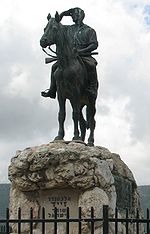Sheikh Bureik

Sheikh Bureik (Arabic: الشيخ بريك او الشيخ اِبريق), locally called Sheikh Abreik or Sheikh Ibreik in recent times, was a Palestinian Arab village located 10 miles (16 km) southeast of Haifa. Situated at an ancient site that shows evidence of habitation as early as the Iron Age, it was known as Beit She'arayim in the Roman and Byzantine periods and became an important center of Jewish learning in the 2nd century, with habitation continuing during the Early Islamic period and limited signs of activity from the Crusader period.The village appears under the name Sheikh Bureik in 16th century Ottoman archives. Named for a local Muslim saint to whom a shrine was dedicated that remains standing to this day, it was a small village whose inhabitants were primarily agriculturalists. Rendered tenant farmers in the late 19th century after the Ottoman authorities sold the village lands to the Sursuk family of Lebanon, the village was depopulated in the 1920s after this family of absentee landlords in turn sold the lands to the Jewish National Fund. A new Jewish settlement, also named Sheikh Abreik, was established there in 1925. Excavations at the site in 1936 revealed the ancient city, known in Greek as Besara and identified as Beth Shearim by Benjamin Mazar. The excavated part of the ancient town has become the Beit She'arim National Park, which is managed by the Israel Nature and Parks Authority.
Excerpt from the Wikipedia article Sheikh Bureik (License: CC BY-SA 3.0, Authors, Images).Sheikh Bureik
Emek Izrael Regional Council Agudat HaShomrim
Geographical coordinates (GPS) Address Nearby Places Show on map
Geographical coordinates (GPS)
| Latitude | Longitude |
|---|---|
| N 32.702222222222 ° | E 35.129166666667 ° |
Address
3608002 Emek Izrael Regional Council, Agudat HaShomrim
North District, Israel
Open on Google Maps










